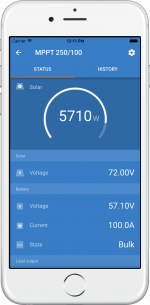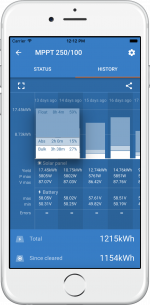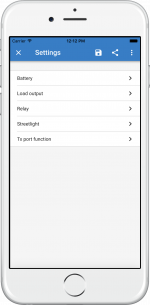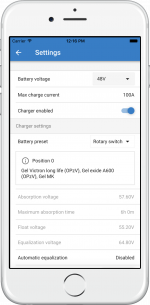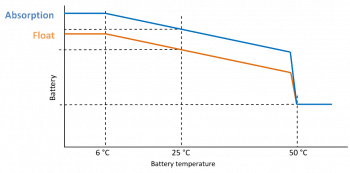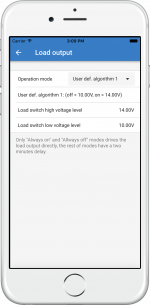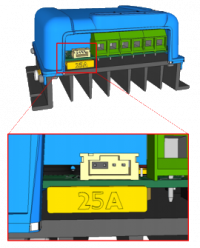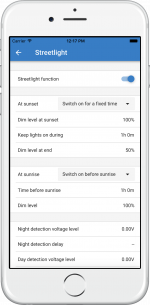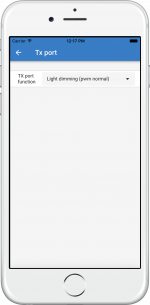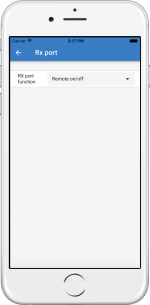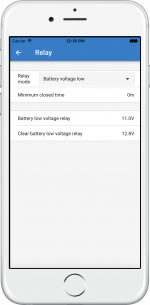This is an old revision of the document!
Table of Contents
VictronConnect - MPPT Solar Charge Controllers
1. Introduction
Thank you for using VictronConnect. This guide will help you get the most out of your MPPT Solar Charge Controller. The information available here applies to all BlueSolar and SmartSolar MPPT Charge Controllers which are compatible with VictronConnect. A list of all VictronConnect compatible devices can be viewed here.
More general information about the VictonConnect App - how to install it; how to pair it with your device; and how to update firmware, for example - can be found by referring to the overall victronconnect.
Note: Where battery voltage is referred to in these instructions, a 12V battery is assumed. Please multiply the given values by 2, 3 or 4 to arrive at settings for an installation configured for 24V, 36V or 48V respectively.
2. STATUS - Live Data Information
- MPPT [Model Number] confirms the connected device. A custom name can also be set if desired.
- Solar 'Gauge' icon shows the dynamic real-time power output from the solar array. With regard to the Solar Panel voltage, note that the Solar charger will only operate once the Panel voltage has risen more than 5V above battery voltage.
- Battery - Voltage The voltage measurement is taken at the battery terminals of the Solar charger.
- Battery - Current This reading shows the current flowing-to, or drawn-from the battery terminals of the Solar charger. Note that in the case of the 100/20 Solar chargers and smaller - which have a dedicated load output - a Positive notation alongside the current reading means that current is flowing to the battery; whereas a Negative notation means that current is being drawn from the battery.
- Battery - State:
- Bulk: During this stage the Controller delivers as much charge current as possible to rapidly charge the batteries. When the battery voltage reaches the Absorption voltage setting, the Controller activates the Absorption stage.
- Absorption: During this stage the Controller switches to the constant voltage mode, where a pre-set absorption voltage, suitable to the battery type (See section 4.1 Battery Settings below), is applied. When the charge current decreases below the Tail current and/or the pre-set Absorption time has elapsed, the battery is fully charged. The Controller switches to the Float stage. The Tail current is 1A for models 100/20 and smaller; and 2A for larger models. (When an automatic equalisation is being performed this will also be reported as 'Absorption'.)
- Float: During this stage the float voltage is applied to the battery to maintain a fully-charged state.
- Equalization: This is shown when 'Start equalization now' is pressed in the battery settings. The charger applies the equalization voltage to the battery as long as the current level stays below 8% (Gel or AGM) or 25% (tubular plate) of the bulk current.
* Menu items only available on models with load output (100/20 and smaller.)
- Load output on/off The function of the load output switch is to disconnect the load when the battery is low on power in order to avoid damaging it. See the configuration section (4.2 below) for available load switching algorithms.
- Load current This shows the current being drawn by electronic devices, lights, fridge, etc.
Note that for the load output reading to be reliable, all loads must be wired directly to the load output …including their negative terminals. See manual or consult your installer for details.
Note that some loads (especially inverters) are best connected directly to the battery. In such cases the load output does not show a reliable reading - the current drawn by the inverter, for example, will not be included. Consider adding a BMV battery monitor which will measure all current going to - or being drawn from the battery, including loads connected directly to the battery …not just the load output terminals of the charge controller.
Is my battery being charged?
The battery will be charged whenever the power available from the PV panels exceeds the power being drawn by the loads (lights, fridge, inverter, etc.).
You can only tell if that is the case with Charge Controllers which have all loads connected to the load output terminals. Remember: any loads connected directly to the battery can't be monitored by the Solar Charger.
3. HISTORY - Thirty-day Graphic
(The fragmented square icon (top left) allows you to toggle between 'portrait' and 'landscape' screen presentations.)
A summary of activity for the last 30 days is presented graphically. Swipe the bar left or right to show any of the previous 30 days.
The daily log shows:
- Yield: The energy converted for that day.
- P max: The maximum power recorded during the day.
- V max: The highest voltage from the PV array during the day.
Clicking on any day/bar in the graph will expand the information to show charge-status times - both as hrs/m; and also as a percentage of the 'charge' day. This graphic provides an at-a-glance representation of how much time your charger is spending in each of three modes: Bulk / Absorption / Float.
Tip! You can use the charge times to see if the PV array is properly sized for your requirements. A system which never reaches 'Float' may need more panels; or perhaps the load could be reduced?
(If you are operating an ESS (Energy Storage System) the charge time for this will be included in the 'Bulk' reading.)
Battery Voltage
The first figure shows the maximum battery voltage for the day …the figure below is the minimum battery voltage.
Consumption (only on 100/20 models and smaller)
Shows the energy consumed by loads connected to the load output terminal.
Errors
Shows the number of errors (if any) for the day, to see the error codes click on the orange point. See MPPT Solar Charger Error Codes.
(You may need to slide the display on your device up to see the errors.)
Total
This shows the total energy converted by the installation and is not re-settable.
Since Cleared
This shows how much energy has been converted by the installation since the last reset.
4. Settings
The settings page is accessed by clicking on the Cog icon at the top right of the Home page. The settings page provides access to view or change the settings of the Battery; Load; Streetlight; and Port functions. From this page you can also view Product information such as the Firmware versions installed on the MPPT Solar Charger.
4.1 Battery settings
For small MPPT Solar Charger models there is only one preset. Larger models feature a rotary switch, the battery page shows the setting of the rotary switch.
We recommend using the rotary switch to select one of the pre-programmed charge algorithms.
Battery voltage
Set the battery voltage to a fixed voltage (12, 24, 36, 48).
The battery voltage is automatically selected at the very first power-up of the charger. The detected figure is stored, and further automatic detection is disabled. If, however, the battery voltage is absent (or below 7 volts) the unit operates as a 12V model and automatic detection is rescheduled for the next power-up.
Note that 36 and 48 volt operation is only available on models which support these voltages - such as the MPPT 150/35. Note also that 36 volts cannot be detected automatically. Systems operating at this voltage must always be set manually.
Hint: if you just want to update the firmware of a device while still keeping the automatic voltage detection active (e.g. before shipping a unit to the end customer), update the firmware as you normally would do. When the firmware update is complete, at the “Live Data Information” page select to cog wheel in the upper right corner, next the three vertical dots in the upper right corner and make sure to choose “Reset to defaults” from the drop-down menu. Now power down the unit, when the unit is powered up the next time it will perform an automatic voltage detection.
Max charge current
Allows the user to set a lower maximum charge current.
Charger enabled
Toggling this setting turns the Solar Charger off. The batteries will not be charged. This setting is intended only for use when carrying-out work on the installation.
Charger settings - Battery preset
Battery preset allows you to select the battery type; accept factory defaults; or enter your own preset values to be used for the battery charge algorithm. The Absorption voltage, Absorption time, Float voltage, Equalisation voltage and Temperature compensation settings are all configured to a preset value - but can be user-defined.
User-defined presets will be stored in the preset library - in this way installers will not have to define all the values each time they are configuring a new installation.
By selecting Edit Presets, custom parameters can be set as follows:
Absorption Voltage
Set the absorption voltage.
Absorption time limit (hh:mm)
Set the absorption time limit. Only available when using a custom charge profile.
Enter the time value in the notation hh:mm, where hours are between 0 and 12; and minutes are between 0 and 59.
The maximum duration of the absorption period is determined by the battery voltage as measured just before the solar charger begins operation each morning (12V battery assumed):
| Battery voltage Vb (@start-up) | Multiplier | Maximum absorption times |
|---|---|---|
| Vb < 11.9V | x 1 | 06:00 hours |
| > 11.9V Vb < 12.2V | x 2/3 | 04:00 hours |
| > 12.2V Vb < 12.6V | x 1/3 | 02:00 hours |
| Vb > 12.6V | x 1/6 | 01:00 hours |
The multiplier is applied to the absorption time limit setting and this results in the maximum duration of the absorption period used by the charger. The maximum absorption times shown in the last column of the table are based on the default absorption time limit setting of 6 hours.
Additionally when the charge current decreases below the Tail current, the battery is fully charged. The Absorption stage ends before the Absorption time has expired. The Tail current is 1A for models 100/20 and smaller; and 2A for larger models.
Float voltage
Set the float voltage.
Equalization voltage
Set the equalization voltage.
Auto Equalization
Set-up the frequency of the auto equalize function. Available options are between 1 and 250 days:
- 1 = daily
- 2 = every other day
- …
- 250 = every 250 days
Equalization is typically used to balance the cells in a lead battery, and also to prevent stratification of the electrolyte in flooded batteries. Whether (automatic) equalization is necessary, or not, depends on the type of batteries, and their usage. Consult your battery supplier for guidelines.
When the Automatic equalization cycle has initiated, the charger applies an equalization voltage to the battery as long as the current level stays below 8% (Gel or AGM) or 25% (tubular plate) of the bulk current.
Duration of the Automatic equalization cycle
In the case of all VRLA batteries and some flooded batteries (algorithm number 0, 1, 2 and 3) automatic equalization ends when the voltage limit (maxV) has been reached, or after a period equal to (absorption time/8) - whichever comes first.
For all tubular plate batteries (algorithm numbers 4, 5 & 6); and also for the user-defined battery type, automatic equalization will end after a period equal to (absorption time/2).
For the Lithium battery type (algorithm number 7), equalization is not available.
When an automatic equalization cycle is not completed in one day, it will not resume the next day. The next equalization session will take place according to the interval set in the 'Auto Equalization' option.
For units without a rotary switch (75/10; 75/15; 100/15 & 100/20) the default battery type is a VRLA battery and any user-defined battery will behave as a tubular plate battery with regard to equalization.
Start Equalization now
Selecting 'Start Equalization now' allows manual initiation of an Equalization cycle. To allow the charger to equalize the battery properly use the manual equalize option only during absorption and float periods, and when there is sufficient sunlight. Current and voltage limits are identical to the automatic equalize function. The duration of the equalisation cycle is limited to a maximum of 1 hour when triggered manually. Manual equalization can be stopped at any time by selecting 'Stop Equalize'. Note that manual equalization is not available on all models.
Temperature compensation
Many types of battery require a lower charge voltage in warm operating conditions, and a higher charge voltage in cold operating conditions.
The configured coefficient is in mV per degree Celsius for the whole battery bank, not per cell. The base temperature for the compensation is 25°C (77°F), as shown in the chart below.
With a Smart Battery Sense is installed; the actual battery temperature will be used for compensation; throughout the day.
In case there is no external source for battery temperature; charger uses its internal temperature for battery temperature compensation. The temperature reading is taken in the morning; when the charger has been idle for at least one hour, i.e. when the charger is not actively charging a battery or supplying a load.
Low temperature cut-off
This setting is available when a VE.Smart network is set-up and the battery temperature is available (e.g. by for example using a Smart Battery Sense or a Smart BMV with the optional temperature sensor). It can be used to disable charging at low temperatures as required by Lithium batteries.
For Lithium Iron Phosphate batteries this setting is preset at 5 degrees Celsius, for the other battery types it is disabled. When creating a user defined battery the cut-off temperature level can be adjusted manually.
See the VE.Smart Network manual for details on what devices are capable of transmitting temperature.
4.2 Load output
This section applies to all products. These settings are typically used on the smaller models which have a dedicated load output (75/10, 75/15, 100/15 and 100/20).
For larger models without a load output, the load settings can be used to drive the TX pin in the VE.Direct port, which can then be used to drive a BatteryProtect relay or other load-shedding device. See chapter 4.4 Tx port function, option 5: Virtual Load output, for more information.
The available programs are:
- Always off
- BatteryLife algorithm: Self adapting algorithm to maximize life of the battery. See manual for details.
- Conventional algorithm 1: Off when Vbatt < 11.10V. And On when Vbatt > 13.10V. (12V battery assumed)
- Conventional algorithm 2: Off when Vbatt < 11.80V. And On when Vbatt > 14.00V.
- Always on
- User defined algorithm 1: Off when Vbatt < Vlow. And On when Vbatt > Vhigh.
- User defined algorithm 2: Off when Vbatt < Vlow or Vbatt > Vhigh. And On when Vbatt between Vlow and Vhigh.
- Automatic Energy Selector: Off when Vbatt < Vlow. And On when Vbatt > Vhigh. When conditions are met Load will be on for a pre-selected time. Note; This mode is only available on SmartSolar Models.
Note that, by default, the models with a load output have their algorithm selected with a jumper in the VE.Direct port. This can be disabled using the VE.Direct Rx pin configuration (see 4.5 below). Or remove the jumper from the VE.Direct port when using VictronConnect to configure the load ouput operation mode, the drawing below shows where the jumper is located.
Keep in mind that modes 1 (always off) and 5 (always on) will respond immediately. The other modes, sensing the battery voltage, have a delay of 2 minutes before the load output changes. This is so that the charger does not respond too quickly when, for example, an inrush current briefly lowers the battery voltage below the threshold.
Larger models offer a 'Streetlighting Algorithm' (see 4.3 below); this too will be 'controlled' by the Load Output settings in order to protect the battery from being too deeply drained: Streetlight settings will be overridden if the battery voltage falls below a chosen value. When the battery voltage is restored to chosen parameters, the Streetlighting function will resume. In this way the two functions work together.
The load output (on the smaller MPPT models) always acts as a switch - off when load output is off or streetlight dimming is at 0%; and on when load output is on and streetlight dimming is between 1 and 100% (see 4.3 below: Gradual Dimming speed).
Use the optional VE.Direct TX digital output cable, ASS030550500, accessory.
4.3 Streetlight settings
The Streetlight function allows you to automatically control night lighting - it's duration, and brilliance. When the Streetlight function is enabled a timer program can be created whereby 'sunset' and 'sunrise' are used as the anchor points for the timer program. The advantage of this is that the programme will adjust itself to the duration of night-time as it changes with the season. Note that the internal clock will need a few days of uninterrupted operation to synchronize with sunrise and sunset and whilst this is happening a 12-hour day, and a 12-hour night will be assumed.
At sunset you can choose from the following actions:
- Take no action (light remains off).
- Turn the light on, and then off after a chosen number of hours. Two dim-levels can be entered …one for the “on” period; and a second for the “off” period. (Use 0% to switch the light off during the night).
- Turn the light on …and then off at (solar) midnight. (Note that 12 o' clock midnight differs from the solar midnight - which is the mid-point between sunset and sunrise. The charger will need to operate for several days to synchronize with the solar activity in your area.) Two dim-levels can be entered: one for the “on” period (up to midnight) and a second dim-level for the “off” period after midnight. (Use 0 to switch the light off during the night).
- Turn the light on, and then off at sunrise. Note when this option is chosen the sunrise control actions are no longer shown.
At sunrise you can choose to:
- Turn the light off at sunrise.
- Turn the light on for a chosen number of hours before sunrise; and then turn the light off at sunrise. Note that the charger needs to synchronize with the solar activity in order to predict the time of sunrise. This takes several days.
FOR EXAMPLE: The selections which have been made on the iPhone screen image above (please click image for expanded view) will have the following effect on the Streetlight controls:
- At sunset - the light will be switched on for a fixed time
- Dim level at sunset - at Full brilliance (100%)
- Keep lights on during - the duration has been set to 1h 0m
- Dim level at end - at the end of one hour the brilliance will be reduced to half (50%)
Also;
- At sunrise - the lighting will be adjusted before sunrise
- Time before sunrise - at 1h 0m before sunrise, the following adjustment will be made:
- Dim level - full brilliance will be restored (100%)
NB: This dim-levels menu only appears when the TX port function is set to PWM (see 4.4 below).
After making your settings the charger will use 'local time' for 5 days whilst synchronising with solar activity. During this period the charger should remain powered-up. If not, it will work on the assumption that midnight occurs 6 hours after sunset and will continue with this assumption until local synchronisation has taken-place.
The lighting controller (timer) program is written to non-volatile memory, so the program will remain intact when the charger is disconnected from the battery.
When entering a 'switch-on' instruction a dim level can also be entered, this results in a signal being sent to the TX port when the VE.Direct port is set to this mode (refer to Chapter 4.4 below).
Mid-point shift
The time of midnight is estimated based on solar activity, and depends on your geographical location. Remember, too, that daylight saving times cause a further deviation between 'solar' and 'clock' midnight. By using the Mid-point shift function this can be compensated for. (Note that this setting is only relevant when your timer program uses 'Midnight' as a switching moment …as in option 3 above). Use 0 to disable the shift (default).
Calculation Example:
For calculation we use a 1440-minute day.
Where Sunset is at 19:00 (1140 minutes); and Sunrise is at 6:25 (385 minutes)
- Night duration in minutes is: 1440m(min/day) -1140m(time to sunset) + 385m(time to sunrise) = 685m
- Degree of shift = time of sunset (in minutes) +half the duration of night (in minutes) - length of day (in minutes) = 1140m +342m-1440m = 42 minutes
Night and day detection
Night/day detection voltage settings can be used to adjust the detection to match the panel configuration. The day detection voltage must be 0.5V higher than the night detection level. The lowest detectable voltage is 11.4V. Set this option to 0 to use the built-in defaults which are: Night = Vpanel<11.4V Day = Vpanel>11.9V).
The default setting is 0 (use built-in default voltages)
Using the 'Delay' periods for day/night changeover avoids the system making an accidental switch when clouds pass over the panels. The valid range is between 0…60 minutes. These delays are disabled by default (0).
Gradual dimming speed
The gradual dimming option can be used to slow down the response of the timer program. This is useful when multiple chargers are used in a row, and helps to mask the fact that each timer uses its own detection and the transition moment which will vary from unit to unit.
The dimming settings can be adjusted. You can input the number of seconds required to achieve each percentage-point of change (x seconds/per 1% of dimming). The available setting parameters are 0 …99
* 0 = immediate response (gradual dimming disabled)
- A setting of '0' will achieve an immediate response - so the gradual dimming option is disabled.
* 9 = dim from 0 to 100% in 15 minutes.
- Setting the dimming speed to 9, for example, slows down the dimming speed to 15 minutes (9 seconds for each percentage point of dimming x 100 percentage points = 900 seconds or 15 minutes.
Note: Make sure the TX port function is set to Light dimming mode (as described in the next chapter) and connect a VE.Direct TX digital output cable to the PWM dim input of your LED driver.
4.4 Tx port function
This setting defines the function of the Tx pin located inside the VE.Direct connector. Use the VE.Direct TX digital output cable, ASS030550500 to access - and therefore receive signals from - the pin.
Available options:
- Normal communication (default). Use this when connecting to a Color Control GX, a VE.Direct Bluetooth Smart dongle, or any other device that needs to communicate with the MPPT.
- Pulse every 0.01 kWh. Selecting this option causes a pulse to be emitted for every 0.01kWh of energy harvested, the TX port is normally high and will be driven low for approximately 250ms for every 0.01kWh harvested. This function is useful in combination with an energy meter.
- Light dimming (pwm normal). Use this function in combination with the Streetlight algorithm. PWM will be at 100% duty cycle when full light intensity is required.
- Light dimming (pwm inverted). Use this function in combination with the Streetlight algorithm. PWM signal will be 0% duty cycle when full light intensity is required.
- Virtual load output. The TX pin will switch in harmony with the load output port. The purpose of this is to use the BatteryLife algorithm, or Streetlight algorithm, on the larger models which do not have a dedicated load output. Connect the VE.Direct TX digital output cable to a BatteryProtect module or a solid state relay.
Notes:
- The PWM signal output (when using options 3 and 4) operates at a fixed frequency of 160Hz and has a fixed voltage level of 5V.
- Using options 2 through to 5 does not disable the ability of the unit to communicate - what happens is that the unit will automatically detect incoming data, and whilst that data is being received it will resume normal communication (as in option 1) for the duration of that data-reception. When the unit detects that the data-reception has been completed, it will automatically resume whichever option (2 -5) has been manually selected.
4.5 Rx port function
The Rx pin on the VE.Direct connector can be used for other functions. This functionality was introduced in firmware version 1.17 and applies to the 10A, 15A and 20A chargers with a load output. Available options:
- Remote on/off (This is the default setting on all larger models). This setting allows remote on/off control: (0V = switch charger off, +5V (or a signal sent via VE.Direct communication) = switch charger on). An example of this operation is when the unit is connected to a VE.BUS BMS (using a VE.Direct non inverting remote on-off cable, ASS030550300).
- Load output configuration (This is the default setting on the following models: 75/10, 75/15, 100/15 and 100/20). The Tx pin can be used to place a jumper to select load output operation. See Load output chapter (4.2 above) for details.
- Load output on/off inverted This setting reverses the load output on/off control: (0V = switch load output on, +5V = switch load output off)
- Load output on/off normal This setting allows load output on/off control: (0V = switch load output off, +5V = switch load output on)
Note: These settings work in a similar way to a remote on/off switch, but instead they control the load output.
5. Programmable relay
A programmable relay switch is available on some SmartSolar models. The datasheet for your model will tell you whether or not it is available.
The relay offers three connections:
- NO (Normally Open)
- C (Common)
- NC (Normally Closed)
| Relay state | Connection between |
|---|---|
| Switched ON | C and NO |
| Switched OFF | C and NC |
The conditions for switching the relay depend on the relay mode setting, note that the conditions for switching over must be present for at least 10 seconds before the relay will change position.
Relay mode
- Relay always off. This option switches the relay OFF. It will disable the other relay options. Use this option if you do not plan to use the relay function.
- Panel voltage high. This option switches the relay ON when the panel voltage becomes too high. See Panel voltage high mode settings below.
- High temperature (Dimming). This option switches the relay ON when the charger output current is reduced due to high temperatures. Use this option to for example switch an external fan.
- Battery voltage Low. This option switches the relay in ON when the battery voltage falls too low, see Battery voltage Low settings below. This is the default setting when the relay function is active.
- Equalization active. This option switches the relay ON when the manual equalization mode is active.
- Error state. This option switches the relay ON when there is an error.
- Defrost option (Temp < -20?). This option switches the relay ON when the Charger temperature falls below -20 degrees Centigrade.
- Battery voltage high. This option switches the relay ON when the battery voltage is too high, see Battery voltage High settings below.
- Float or Storage state. This option switches the relay ON when the charger is in the float state.
- Day detection (Panels irradiated). This option switches the relay ON whilst the solar panels are providing energy (Day/Night detection).
- Load output. This option switches the relay ON and OFF according to the settings chosen in 'Load Output' (4.2 above): Load on = Relay switched ON. Load off = Relay switched OFF. The purpose of this is to use the BatteryLife algorithm, or Streetlight algorithm, on the larger models which do not have a dedicated load output.
Panel voltage High settings
- Panel high voltage. (User-defined Voltage)
- Clear panel high voltage. (User-defined Voltage)
This option switches the relay ON when the panel voltage rises above the chosen “Panel high voltage” setting, and switches the relay OFF when the panel voltage falls below the chosen “Clear panel high voltage” setting. Ensure, of course, that the “Panel high voltage” setting is greater than the “Clear panel high voltage” setting. These settings must never exceed the maximum voltage-rating allowed by your MPPT charger.
Battery voltage Low settings
- Battery low-voltage relay. (The default setting for this is 10.00V) (12V battery assumed)
- Clear battery low-voltage relay. (The default setting for this is 10.50V)
These settings, which can be user-defined, will cause the relay to switch ON when the battery voltage falls below the chosen “Battery low-voltage” setting; and will cause the relay to switch OFF when the battery voltage once again rises above the “Clear battery low-voltage” setting. Ensure, of course, that the “Battery low-voltage relay” setting is lower than the “Clear battery low-voltage relay” setting.
An application for this feature, for example, is to automatically disconnect a load in order to prevent a battery from becoming too deeply discharged.
Battery voltage High settings
- Battery high-voltage relay. (The default setting for this is 16.50V) (12V battery assumed)
- Clear battery high-voltage relay. (The default setting for this is 16.00V)
These settings, which can be user-defined, will cause the relay to switch ON when the battery voltage rises above the “Battery high-voltage relay” setting; and will cause the relay to switch OFF when the battery voltage drops below the “Clear battery high-voltage relay” setting. Ensure, of course, that the “Battery high-voltage relay” setting is greater than the “Clear battery high-voltage relay” setting.
An application for this feature, for example, is to disconnect a load in order to protect it from an over-voltage.
General settings
- Minimum closed time. (The default setting for this is 0 minutes)
This option sets a minimum-time for the ON condition to prevail once the relay has been switched ON.
An application for this feature, for example, is to set a minimum generator run-time.
DISQUS
~~DISQUS~~
 Add this page to your book
Add this page to your book  Remove this page from your book
Remove this page from your book  Manage book (
Manage book ( Help
Help 